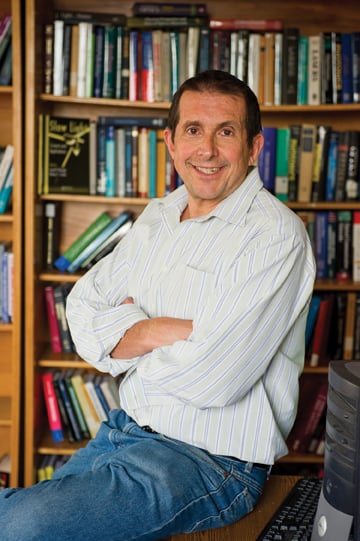 Jacob Khurgin, professor of electrical and computer engineering, wastes no words describing his research in quantum electronics and nonlinear optics: “I’m a theorist,” he says. “My current work is on quantum cascade lasers.”
Jacob Khurgin, professor of electrical and computer engineering, wastes no words describing his research in quantum electronics and nonlinear optics: “I’m a theorist,” he says. “My current work is on quantum cascade lasers.”
He reserves his energy for the research, which bubbles across a number of fields. His 2008 book, Slow Light: Science and Applications, which he co-edited with Rodney S. Tucker, pioneered the field of manipulating light speed in various media, from semiconductors to photonic structures. This summer he will publish a major chapter in another groundbreaking book, this one from World Scientific Books, titled Plasmonics and Plasmonic Metamaterials: Analysis and Applications. It is edited by Igor Tsukerman, an engineering professor at the University of Akron.
“We need the ability to manipulate light,” says Khurgin, explaining the core of his work. Light’s uniform speed has benefits for designing applications, he notes, “but for some applications, you want to slow it down.” He compares it to radio waves: “It’s very easy with an electronic signal, very difficult with photons.”
Khurgin has spent this academic year at Princeton University as the Kenan Visiting Professor for Distinguished Teaching in the Department of Electrical Engineering, where he has taught both fall and spring semesters. But his focus has been on his research-a collaboration with Mid-Infrared Technologies for Health and the Environment (MIRTHE), a Princeton-based, NSF-funded center in which Johns Hopkins is a partner.
“I basically help design lasers, exploring the underlying physical processes that make them work,” he says of his work with MIRTHE.
The lasers he designs are unlike any seen before. Quantum cascade lasers, for example, operate in the mid-infrared region, a range of long wavelengths beyond conventional optical lasers. Quantum cascade lasers can drive new, trace gas-sensing systems that can detect extraordinarily small amounts of toxins from spills, combustion, or even exhaled breath, according to MIRTHE. Ammonia, for example, can be detected much more quickly in the mid-infrared range than elsewhere in the light spectrum.
Another recent Khurgin innovation, called a tunable delay of an optical signal, permits the “tuning” of light’s speed at will. He’s also developing lasers using phonons, the smallest units of vibrational energy, with wavelengths shorter than ultrasound. “Basically, it’s ultrasound but beyond ultrasound,” he says, and has applications in medicine. “You can use it to detect very small objects.”
Born in Leningrad (now St. Petersburg), Khurgin studied at the St. Petersburg Institute of Precision Mechanics and Optics, and received his PhD from Polytechnic University of New York. Before joining the Hopkins faculty he spent several years at Philips Laboratories in New York, designing high-brightness projection TV sets and 3-D television components.
The forthcoming book ranks Khurgin among the world’s leaders in the fields of plasmonics and metamaterials, says Tsukerman, the book’s editor-fields that will “revolutionize the ways of generating, controlling, and processing light on the nanoscale.”




